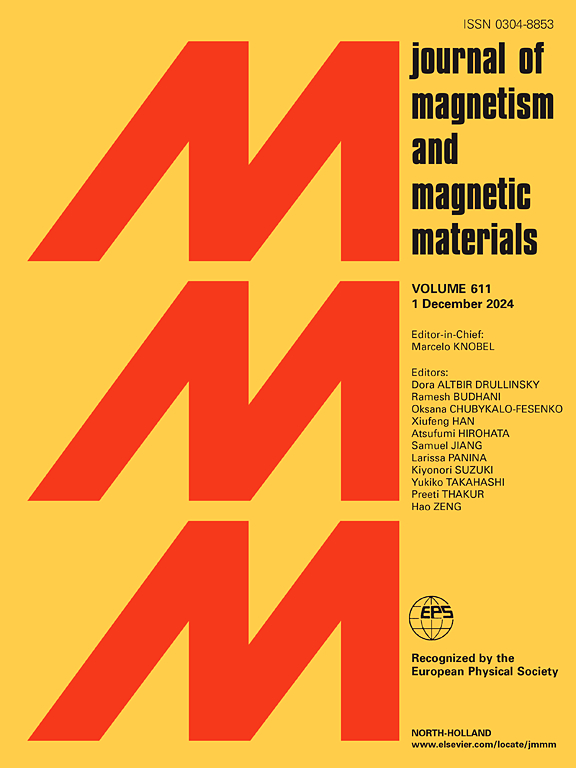氧化镁替代六价铁锶粉末的影响:晶体结构和磁性能研究
IF 2.5
3区 材料科学
Q3 MATERIALS SCIENCE, MULTIDISCIPLINARY
引用次数: 0
摘要
由于应用广泛,电气设备和非电气设备对磁铁的需求大幅增加。六价锶铁氧体(SrFe12O19)硬磁体因其优异的性能而脱颖而出,包括高磁饱和度(Ms)、矫顽力(Hc)、居里温度和化学稳定性。为了进一步提高(SrFe12O19)的性能,有必要掺杂特定元素。本文采用粉末冶金法制备了添加氧化镁(0 %、0.5 %、1 %、1.5 %、2 % wt)的(SrFe12O19)磁粉。通过 TG-DTA(热重-差热分析)、XRD(X 射线衍射)和 VSM(振动样品磁力计)研究了材料的特性。DTA 检测到,SrFe12O19 的形成发生在 1000 °C 以上,质量减少率仅为 0.344096 %。因此,样品的煅烧温度为 1100 ℃。氧化镁的添加导致晶粒尺寸减小,在 2% 氧化镁时观察到的晶粒尺寸最小(舍勒法测定为 36.78 nm,XRD 分析为 38.40 nm)。此外,氧化镁掺杂还显著提高了磁矫顽力,最大值达到 3.437 kOe。矫顽力的提高归因于镁的替代导致晶体各向异性场的增加,这证明了镁对改善矫顽力场的内在影响。本文章由计算机程序翻译,如有差异,请以英文原文为准。
The impact of magnesium oxide substituted strontium hexaferrite powder: Investigation on crystal structure and magnetic properties
The demand for magnets in both electrical and non-electrical equipment has seen a significant rise due to their diverse applications. Strontium Hexaferrite (SrFe12O19) hard magnet stand out for their excellent properties, including high Magnetic Saturation (Ms), Coercivity (Hc), Curie Temperature, and Chemical Stability. To further improve the properties of (SrFe12O19), doping with specific elements is necessary. In this article, (SrFe12O19) magnetic powder was prepared with MgO (0 %, 0.5 %, 1 %, 1.5 %, 2 % wt) addition using the powder metallurgy method. The characteristics of materials were studied through TG-DTA (Thermo-gravimetric – Differential Thermal Analysis), XRD (X-ray Diffraction), and VSM (Vibration Sample Magnetometer). DTA detects that the formation of SrFe12O19 occurs above 1000 °C with a mass reduction of only 0.344096 %. Thus, the sample calcination is conducted at 1100 °C. The addition of MgO led to a decrease in crystallite size, with the smallest crystallite size (36.78 nm by the Scherrer method and 38.40 nm analyzed by XRD) observed at 2 % MgO. Furthermore, MgO doping significantly increased the magnetic coercivity, reaching a maximum value of 3.437 kOe. This enhancement in coercivity is attributed to an increase in crystal anisotropy fields caused by Mg substitution, demonstrating the instrinsic effect of Mg on improving the coercive field.
求助全文
通过发布文献求助,成功后即可免费获取论文全文。
去求助
来源期刊

Journal of Magnetism and Magnetic Materials
物理-材料科学:综合
CiteScore
5.30
自引率
11.10%
发文量
1149
审稿时长
59 days
期刊介绍:
The Journal of Magnetism and Magnetic Materials provides an important forum for the disclosure and discussion of original contributions covering the whole spectrum of topics, from basic magnetism to the technology and applications of magnetic materials. The journal encourages greater interaction between the basic and applied sub-disciplines of magnetism with comprehensive review articles, in addition to full-length contributions. In addition, other categories of contributions are welcome, including Critical Focused issues, Current Perspectives and Outreach to the General Public.
Main Categories:
Full-length articles:
Technically original research documents that report results of value to the communities that comprise the journal audience. The link between chemical, structural and microstructural properties on the one hand and magnetic properties on the other hand are encouraged.
In addition to general topics covering all areas of magnetism and magnetic materials, the full-length articles also include three sub-sections, focusing on Nanomagnetism, Spintronics and Applications.
The sub-section on Nanomagnetism contains articles on magnetic nanoparticles, nanowires, thin films, 2D materials and other nanoscale magnetic materials and their applications.
The sub-section on Spintronics contains articles on magnetoresistance, magnetoimpedance, magneto-optical phenomena, Micro-Electro-Mechanical Systems (MEMS), and other topics related to spin current control and magneto-transport phenomena. The sub-section on Applications display papers that focus on applications of magnetic materials. The applications need to show a connection to magnetism.
Review articles:
Review articles organize, clarify, and summarize existing major works in the areas covered by the Journal and provide comprehensive citations to the full spectrum of relevant literature.
 求助内容:
求助内容: 应助结果提醒方式:
应助结果提醒方式:


